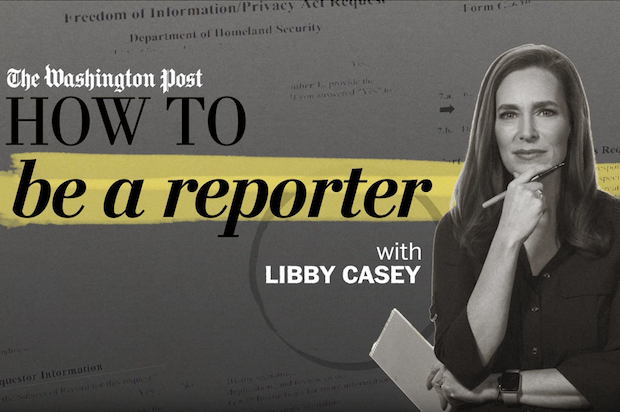The Washington Post has launched a new video series that aims to answer some of the most important questions about how the reporting process works, to build trust with its audience but also to provide insights for people who are already working in journalism or looking to enter the industry.
The series, called 'How to be a journalist', is hosted by Libby Casey, on-air reporter covering politics and accountability at The Post, who said the format is a good opportunity to "bring that transparency and deep level of trust that we have in print to video".
"Video gives you this chance to show, not just tell, what real journalism is and how it works," she told Journalism.co.uk.
"I'm used to having a lot of people in my life, even journalists, ask questions about how we tell a story, or how we fact-check or get information, so this seemed like an opportunity to pull back the curtain a little bit and answer some of the fundamental questions of what we do as reporters."
In the first episode published on 8 December, Casey sat down with Stephanie McCrummen and Beth Reinhard, the two Post reporters who broke the news about sexual assault allegations against Republican candidate Roy Moore. In a six minute video, they explained how the story originated from on-the-ground reporting in Alabama, as well as how they went about finding sources and speaking to them on and off the record.
When choosing the theme of each episode and scripting it, Casey tries to listen to what reporters are talking about, and cover a range of issues and aspects of reporting related to both topical events and more evergreen topics by speaking to Post reporters but also experts and notable figures outside of the building.
"I am trying to think of this with two parts of my brain on: one is, if someone is totally new to this part of journalism, what basic questions do we need to answer?
"But then also if someone is more knowledgeable and more experienced, what nuggets of information can we put in there that they would still find dynamic, revealing or surprising?"
For example, the idea for the first instalment in the series, 'How to be a reporter', came from a paragraph in McCrummen and Reinhard's piece that gave an insight into how they had come across the story and interviewed the women quoted. Casey wanted to delve deeper into how journalists cover a sensitive story and approach potential sources.
The Post will publish two more episodes in December, on how to file a FOIA request and how the whistleblowing process works, for which Casey interviewed Daniel Ellsberg, the former US military analyst who released the Pentagon Papers to the press.
The episodes are published on washingtonpost.com and on social media, and once a few more have aired, they will be compiled into playlists on both the website and YouTube, so they can be easily found by readers, students or journalists searching for these topics online.
The video series builds on The Post's previous efforts to provide more transparency into its reporting process and develop trust with its audience. In March, it launched PostThis, a Facebook group where readers can ask its journalists how and why they cover stories. The outlet is also part of the recently announced Trust Project, in which participating news organisations adopt a set of indicators to help readers identify trustworthy sources, such as providing more information about the type of article published, the author's expertise and how a story is produced.
'How to be a journalist' will resume in January, and at this stage there is no limit for its duration, Casey said. She is planning to also look at aspects such as how to report on war as a foreign correspondent and how to cultivate sources.
"We've already received really positive feedback and people are coming up with their own ideas and throwing them to us, so I also want to hear from our audience about what questions they have.
"Are there parts of the journalism process that they would like to hear more about? Would they like to see how we go about fact-checking, or do they want to learn more about how a newspaper is put together and assembled?
"This is a great opportunity to have that kind of dialogue and hear genuine questions from people that we can answer through these videos."
Free daily newsletter
If you like our news and feature articles, you can sign up to receive our free daily (Mon-Fri) email newsletter (mobile friendly).
Related articles
- Washington Post opinions editor David Shipley on gearing up for the US election
- RISJ Digital News Report 2024: Three essential points for your newsroom
- RISJ Digital News Report 2024: Five trends to watch in the UK
- The Journalism Trust Initiative is rewarding transparent and trustworthy news
- Building trust during 2024 elections with live-blogging and fact-checking










